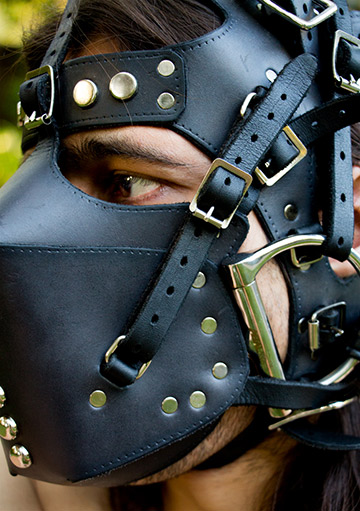
The JG Leathers pony play bridle gives a feeling of restriction and control: even without blinders my vision is restricted; I can only smell the leather of the face mask, and dislogding the bit is out of the question. Photo by cpony.com

The JG Leathers pony play bridle gives a feeling of restriction and control: even without blinders my vision is restricted; I can only smell the leather of the face mask, and dislogding the bit is out of the question. Photo by cpony.com
A bridle fits on a pony's head and is used to control head movement (typically via attached reins). Control over the pony's head allows you to direct the pony when riding or driving.
The addition of blinders (sometimes called blinkers), or possibly even a blindfold, increases this control by allowing the pony to see only in the direction you have pointed his head. In the case where a blindfold has been added, the pony must rely entirely on the rider's commands via the bridle and bit to direct him.
Generally speaking a bridle is designed to hold a bit with a mouthpiece, or alternatively, a "hackamore" attachment (the latter has no mouthpiece and relies on carefully positioned straps to exert pressure on the mose and face).
A halter is not designed to hold a bit or other attachment. While similar in many respects (e.g. both provide some control over the pony's head), a bridle and a halter are not the same.
Typically a bridle will fit very snugly (not necessarily tightly, but tight enough that shaking the head around should not move any straps on the bridle) whereas a halter will fit a little more loosely (if additional control is needed over a pony wearing a halter, a stud chain may be used).
So if it's just holding a bit in place, why have a bridle at all? Why not just use a simple bit gag? A bit gag does indeed work perfectly well, but a bit secured via a bridle is not only more secure but often more comfortable for long term wear as well.
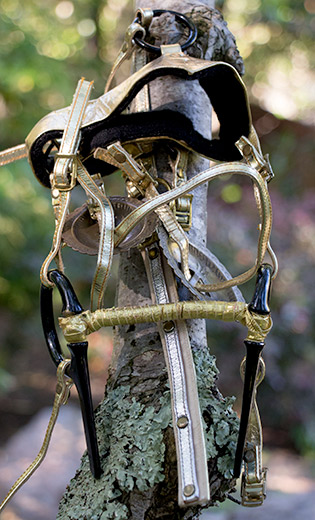
Show bridle. Photo by cpony.
The full head coverage of the bridle straps coupled with the tight integration of bit and bridle helps distribute the weight and pressure of the bit compared to the single strap used with bit gags.
The integration of bit and bridle also facilitates greater control over a pony's head than a bit alone. Rein action on a bit attached to a bridle is often more compelling to the pony than rein action on a bit gag alone.
Moreover, a properly fitted bridle will hold the bit more securely in the pony's mouth making it significantly less likely to become dislodged (either accidentally or purposefully).
For this reason it is important to select a bridle to which a bit can attach directly (rather than simply applying a bit gag over a bridle). In doing the latter, I believe you are missing out on some of the benefits of a bridle.
A bridle adds an element of bondage by providing a greater feeling of restriction. Additionally some bridles come with (or have the option to add) blinders and/or blindfolds, which can further add to level of restriction.
Plumes can also be added, which can add a degree of aesthetic appeal to a show pony (some ponies - including me - find a plume mildly humiliating (not sure why...maybe it adds to the objectification), which may or may not be desired). Finally, when well made, bridles look really good and can help complete the whole pony package.
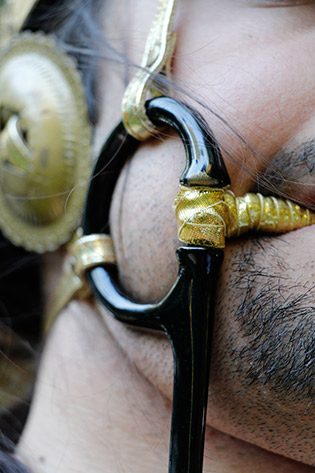
Above gold show bridle worn by me. Photo by cpony.com
Nearly every bridle made for human ponies is designed to hold a bit. Theoretically, any ponyplay bridle that can hold a bit could also be used to attach a hackamore, but I am not aware of any hackamore attachments that will work properly on human ponies. Thus, for now let's assume that if you are using a bridle on your ponyboy, you will also be wanting to attach a bit.
A bit fits in the pony's mouth and is held in place by straps connecting it to the bridle. Many bridles made for ponyplay have a bit (often a rubber snaffle) integrated into the bridle so that it cannot be removed or changed. This is fine for most purposes, but I am really into gags and mouth bondage, so for me the ability to change bits is an essential feature of a bridle.
There are many, many different bits available for bio-equines. Having a bridle that allows you to change bits means you can try pretty much any material, style, or color that suits you - simply order it from a bio-horse tack store and eagerly await delivery of your mouthwatering new toy.
I certainly understand that not everyone really cares about using anything other than a rubber snaffle, but if you are already spending money for a dedicated bridle for ponyplay, I would urge you to at least consider one that allows you free choice of bits (a couple examples are the bridle from Fury Fantasy or the Deluxe Pony Bridle from Fantasy Leather. Though I don't own the bridle from Fantasy Leather, the photos strongly suggest you can interchange bits - I would still double check before ordering if you definitely want this feature).
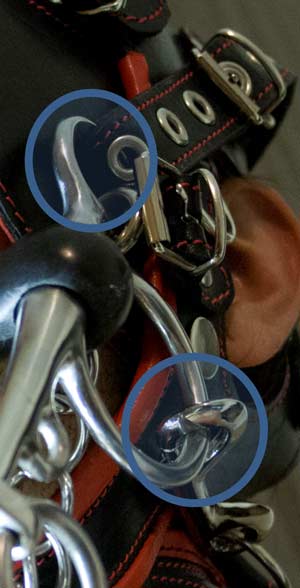
The Csara bridle permits attachment of any bio-horse bit that will fit in a pony's mouth. Straps around the neck and top of the head hold it securely in place. Photo by cpony.com
Ponyplay bridles which allow for (almost) any type of bio-horse bit that the wearer's mouth can accommodate are slowly becoming more common. However, you should also consider how bits attach to the bridle. When shopping for (or making) a bridle for your ponyboy, I would suggest buying one that has at least two straps to hold the bit in place:
The photo on the right shows a bridle (from Csara - unfortunately they have since closed, but they made some nice ponyplay equipment) that secures the bit in this manner. The top shaded circle shows the strap that holds the bit up in the pony's mouth (strap 1 in the list above).
As previously mentioned, this strap acts like a strap going around the top of the head and helps provide the leverage needed for curb bits. The lower shaded circle shows the normal strap (strap 2 in the list above) that pulls the bit back in the pony's mouth by going around the back of the head. I prefer to have strap 1 attach directly to the bridle because this allows the whole setup to be more secure.
The photo at the very top right is a bridle made by JG Leathers (I think he too has also stopped taking orders for equipment, but you could contact him if you're really interested since he still updates his site). Like the bridle from Csara (in fact I think the Csara ponyplay bridle was based on his design), the JGL bridle also holds the bit in place with the additional straps to the upper part of bridle.
Again, this keeps the bit much more secure and allows you to properly use curb bits on your ponyboy (and yes, I know the curb strap is not properly applied in the top photo - it is far too loose to do anything - it was a longish day and wearing the curb strap properly the whole time would have been far too uncomfortable especially with the constant head tilting being asked of me). Moreover, that particular bridle also has a face mask, which really restricts vision (I cannot see down at all) and also gives the feeling of restricted breathing because the air inside heats up really quickly (it also smells wonderfully of leather!).
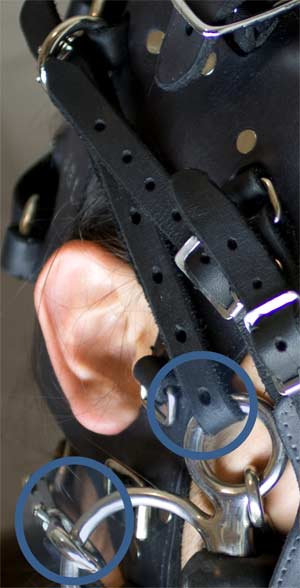
The JGL bridle also allows secure attachment of pretty much any bio-horse bit. Photo by cpony.com
The photo on the right is a close up of the side of the JGL bridle again illustrating the additional strap that makes possible the curb action (top shaded circle) by pulling the bit upwards. Also shown is the standard strap (bottom shaded circle) that pulls the bit directly back into the pony's mouth.
Blinders are one of the most common additions to a bridle. They restrict the peripheral vision of a pony forcing him to concentrate on where he is going and on the trainer's commands. Some bridles take this further and offer a padded band that goes over the nose, which restricts a pony's downward vision as well.
A blindfold can be used in place of blinders. Blindfolded ponyplay is reasonably common both in training and in some types of shows. The complete restriction of vision forces the pony to rely solely on his trainer's rein commands to avoid obstacles.
Having your pony wear a blindfold during training sessions can help build up trust and also teach him to learn nuances in the rein aids. There are also classes in some ponyplay shows where the pony is driven blindfolded.
Another common addition to a bridle, plumes add flair to a pony and are particularly useful for show ponies. They are available in many sizes and colors. Personally, I use a single ostrich feather dyed to match the color of my bridle (red in the case of my show bridle), but more substantial plumes can also be used.
While the style of the bridle used (or desired) depends on the type of ponyplay (e.g. show pony, working pony, etc.), the bridle itself is a useful piece of equipment regardless of the type of pony you have (except perhaps wild ponies). A pony's bridle, along with his bit, is one of the main tools a trainer uses to control a pony.
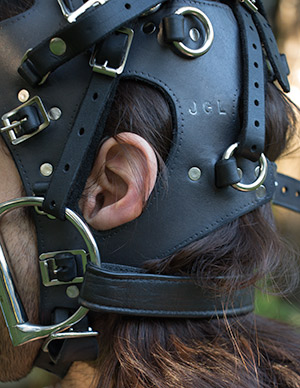
Back of the JGL bridle, illusttating attachment points. Photo by cpony.com
Since it may be worn for long periods (some ponies will take the bit out but keep their bridle on during breaks in play), a bridle should fit well and not pinch any skin, nor should the bridle itself press into any of the pressure points on a pony's head (a hackamore may very well do this when reins are applied, but just a like a bit, a hackamore can also be taken off during breaks in play while still allowing the bridle to remain on the pony).
Do be especially careful that a bridle does not press on any pressure points - add padding if needed. I know from experience this will make a bridle very uncomfortable to wear for even short periods of time and even necessitate ending a play session early.
As mentioned above, halters are also designed to fit on a pony's head, and many halters will bear a resemblance to a pony's bridle. However, halters are not designed to be used with a bit. Halters are mainly used to lead a pony around and as a point of attachment for tying a pony (e.g. to cross ties, or hitching rails).
A halter should be very comfortable; a properly fitting halter should be able to be worn for long periods of time - even longer than a bridle. In practice many ponies do not have a dedicated halter, instead relying on a bridle with bit removed to act in its place.
Head harness is a non-specific term that refers to any piece of equipment that fits on a pony's head. In ponyplay, I typically sub-divide head harnesses into bridles and halters. Other head harnesses exist, such as a ball gag head harness, but they are not specific to ponyplay. Of course, a head harness, such as a ball gag head harness, can be used in ponyplay, and so I kept head harnesses as part of ponyplay tack.
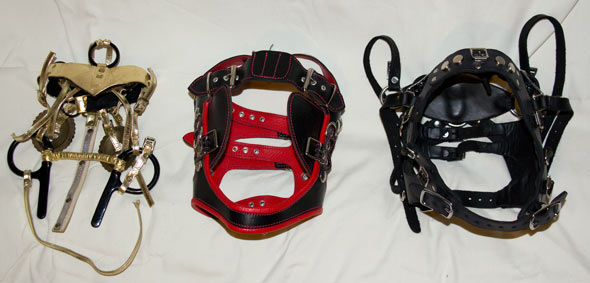
3 pony play bridles. From left to right: Spellbound ponygirl bridle in gold, Csara bridle in red, JG Leathers bridle (mask not shown). Photo by cpony.